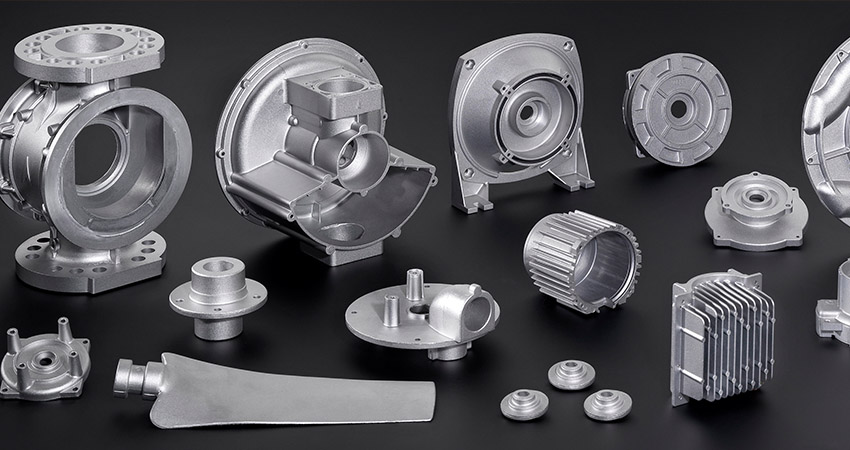Facts About Aluminum Castings Company Uncovered
Wiki Article
Some Known Details About Aluminum Castings Company
Table of ContentsAluminum Castings Company Can Be Fun For EveryoneThings about Aluminum Castings CompanyAluminum Castings Company for Beginners10 Simple Techniques For Aluminum Castings CompanyThe Single Strategy To Use For Aluminum Castings CompanyAluminum Castings Company Things To Know Before You BuySome Of Aluminum Castings CompanyAn Unbiased View of Aluminum Castings Company
There are two primary kinds of die casting utilized in the aluminum casting sector: warm chamber die casting and cold chamber die spreading. The key difference in between these methods is how the molten metal is supplied to the mold. In warm chamber die spreading, typically used for reduced melting factor metals, the melting pot is straight attached to the maker, and a plunger requires the product via a gooseneck into the die cavity.
7 Simple Techniques For Aluminum Castings Company
In these approaches, the mold is deliberately destroyed or damaged away in order to remove the completed light weight aluminum spreading. Usual processes under the category of expendable mold spreading include (investment casting),,, and investment casting. When manufacturing custom-made light weight aluminum parts utilizing expendable molds, makers put liquified aluminum or light weight aluminum alloys into the mold, which is then broken apart to launch the solidified metal part.The is one of the earliest and most utilized kinds of aluminum spreading. It entails condensing specialty factory sand, usually strengthened with clay or material, around a precisely crafted multiple-use pattern that identifies the form and inner details of the finished aluminum item. The pattern system integrates risers and vents to handle the flow of liquified metal and to avoid casting defects such as shrinkage porosity.
9 Easy Facts About Aluminum Castings Company Explained

This mold is then preheated before the pouring of liquified light weight aluminum or light weight aluminum alloy. As the metal fills the covering, it catches the complex details and fine surface area finish of the mold. Once cooled, the ceramic is mechanically or chemically escaped, enabling the removal and separation of individual actors parts.
Aluminum Castings Company - An Overview
Long-term mold spreading utilizes recyclable metal mold and mildews and is perfect for mass production with constant quality and much less waste. Expendable mold spreading makes use of single-use mold and mildews, like sand or foam, providing layout adaptability and lower tooling prices for models or brief runs. Die spreading is best for producing high quantities of aluminum parts that need limited tolerances, great details, and smooth surfaces.The Toshiba Equipment DC-J Series consists of pass away casting equipments suitable for aluminum. Recognized for their robust building and high injection performance, these equipments make sure efficient and precise spreading (Sand Mold).

While aluminum can be utilized in its pure type, it is often alloyed with other steels to boost its residential or commercial properties or the properties of the various other steels. Light weight aluminum alloys are classified right into eight collection, numbered from one to 8.
Aluminum Castings Company Fundamentals Explained
This alloying boosts the stamina and solidity of light weight aluminum however decreases its ductility and corrosion resistance. The 3000 series alloys are primarily alloyed with manganese.Furthermore, it features high ductility and a really smooth ended up surface area. The 4000 series alloys are alloyed with silicon, which lowers the melting factor and enhances fluidity. This makes it a popular choice for casting, as it is easy to develop in its molten state. The 4000 series is also generally made use of as a filler for welding and brazing more info applications.
Fascination About Aluminum Castings Company
This series is identified as a high-strength alloy, particularly suited for sheet and plate applications because of its outstanding weldability. Its resistance to deterioration from acids and alkalis makes it excellent for use in harsh and hostile atmospheres (Metal Foundry). The 6000 collection alloys are alloyed with both magnesium and silicon, providing an equilibrium of stamina, mechanical residential properties, and deterioration resistanceHandling the 6000 series needs specialized and sophisticated devices, which can be complicated and costly. This series is recognized for its outstanding deterioration and oxidation resistance, as well as its convenience of finishing, treatment, and workability. The 7000 collection aluminum alloys are the strongest and most resilient amongst aluminum types, with strength similar to about two-thirds of industrial-grade A3 steel.
What Does Aluminum Castings Company Do?
Zinc is the key alloying component in the 7000 collection, improving the firmness of the light weight aluminum, also though zinc's firmness resembles that of aluminum on the Mohs range. The 8000 series light weight aluminum alloys are largely alloyed with tin, in addition to small quantities of copper and nickel (Aluminum Foundry). While these alloys provide lower stamina contrasted to other collection, they stand out in machinability and put on resistanceLight weight aluminum cast heatsinks are electrically conductive, allowing them to be based successfully. They are typically cast with incorporated features that lessen the requirement for additional operations, such as extra machining or assembly, leading to more expense savings. Aluminum spreading is regularly used to make braces for both heavy-duty industrial equipment and house appliances.
The 4-Minute Rule for Aluminum Castings Company
The single-piece building of aluminum braces boosts their strength and longevity, lowering the chance of failing. If holes are called for, they can be included directly in the spreading mold and mildew, minimizing the requirement for post-production ending up (https://69114834a8b73.site123.me/blog/sand-molding-the-timeless-craft-behind-precision-aluminum-castings). Makers have actually significantly embraced light weight aluminum spreading for golf devices as a result of its sturdiness, stability, and flexibility in shapingReport this wiki page